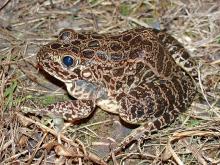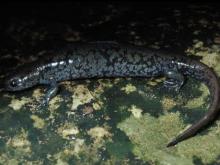Reptiles and Amphibians
Media

Species Types
Scientific Name
Coluber constrictor flaviventris (eastern yellow-bellied racer) and Coluber constrictor priapus (southern black racer)
Description
The eastern yellow-bellied racer is uniformly tan, brown, olive, blue, gray, or nearly black on top, with a yellow, cream, or light blue-gray belly. It occurs nearly statewide. The southern black racer subspecies also lives in the southeastern half of the state.
Media

Species Types
Scientific Name
Thamnophis proximus proximus
Description
The orange-striped ribbonsnake is a type of gartersnake named for the attractive orange or yellow stripes running the length of its body, alternating with wide black stripes. It is found statewide, but seldom far from water.
Media

Species Types
Scientific Name
Lithobates areolatus circulosus
Description
A very secretive species, the northern crawfish frog spends most of its time hidden burrows, typically those made by crayfish. It is restricted to native prairie or former prairie areas and is a species of conservation concern in Missouri.
Media

Species Types
Scientific Name
Anaxyrus woodhousii woodhousii
Description
The Rocky Mountain toad has a number of irregular dark brown or black spots on the back and a white belly. It occurs in the Missouri River floodplain, mostly from the central to the far northwestern parts of the state.
Media

Species Types
Scientific Name
Thamnophis sirtalis sirtalis (eastern gartersnake) and T. s. parietalis (red-sided gartersnake)
Description
The eastern gartersnake and red-sided gartersnake are Missouri's most common gartersnakes. The color is variable, but there are normally three yellowish stripes, one down the back and one on each side. There are narrow black bars between the scales along the upper lip.
Media

Species Types
Scientific Name
Ambystoma tigrinum
Description
Tiger salamanders occur statewide. They spend most of their time underground, often in burrows made by small mammals or under logs and rocks. Your best chance of seeing a tiger salamander is at night after a heavy rain.
Media

Species Types
Scientific Name
Ambystoma texanum
Description
The small-mouthed salamander is a medium-sized, dark gray to black or dark brown salamander with a small head and mouth. In Missouri, it’s found nearly statewide — but not in the Ozarks.
Media

Species Types
Scientific Name
Terrapene ornata
Description
The ornate box turtle usually has four hind toes. Its high-domed shell is usually smooth on top, lacks a ridge, and is brown with yellow lines. Look for it in grassy habitats.
Media

Species Types
Scientific Name
Ambystoma annulatum
Description
The ringed salamander is secretive, spending most of its time under logs or rocks or in burrows. The rings never completely encircle the body. It occurs in the southwestern and central Missouri Ozarks, and in the river hills of the Missouri River in eastern Missouri.
Media

Species Types
Scientific Name
Ambystoma maculatum
Description
The spotted salamander is one of Missouri's six species of mole salamanders. It is slate black with two irregular rows of rounded yellow spots from the head onto the tail. It occurs in forests in the southern two-thirds of the state.
See Also
About Reptiles and Amphibians in Missouri
Missouri’s herptiles comprise 43 amphibians and 75 reptiles. Amphibians, including salamanders, toads, and frogs, are vertebrate animals that spend at least part of their life cycle in water. They usually have moist skin, lack scales or claws, and are ectothermal (cold-blooded), so they do not produce their own body heat the way birds and mammals do. Reptiles, including turtles, lizards, and snakes, are also vertebrates, and most are ectothermal, but unlike amphibians, reptiles have dry skin with scales, the ones with legs have claws, and they do not have to live part of their lives in water.





















